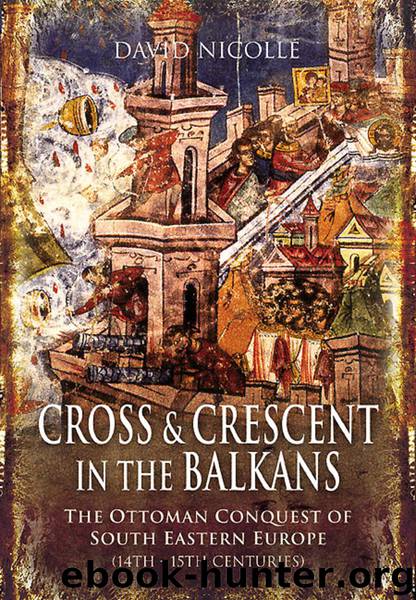Cross and Crescent in the Balkans: The Ottoman Conquest of Southeastern Europe by David Nicolle

Author:David Nicolle [Nicolle, David]
Language: eng
Format: epub
Tags: new
ISBN: 9781844687602
Goodreads: 12017949
Publisher: Pen & Sword
Published: 2011-02-23T05:00:00+00:00
Chapter 13
The Ottomans Survive
The defeat of Sultan Bayezit I by Timur-i Lenk (Tamerlane) in 1402 could have spelled the end of the Ottoman state, but the fact that it did not do so says a great deal for the inherent strength of early Ottoman government and military systems. Though the evidence is not entirely clear, it seems that Bayezit’s sons Musa and Mustafa had also been taken prisoner by Timur-i Lenk after the battle of Ankara, though they were later released, perhaps in the hope of stirring up rivalries and further confusion within the Ottoman state. Bayezit himself died at Akehir in March 1403, after which Timur returned to Central Asia to prepare for his proposed invasion of China. In fact Tamerlane or Tamberlane the bloodstained conqueror died in 1404 while actually leading his army towards the Chinese frontier.
Timur-i Lenk left Anatolia in a situation similar to that which had existed before Bayezit conquered so many of the rival Turkish beyliks in the final years of fourteenth century, several of these beyliks having been given back their independence by Timur. The greatest of these was once again Karaman, which Timur apparently hoped would serve as a strong buffer and vassal state between himself and what remained of the Ottoman Sultanate. Meanwhile the Ottomans were diverted by a civil war between Bayezit’s four sons, each of whom wanted to be ruler. An extraordinary feature of their long struggle was that it remained almost entirely confined within the now reduced Ottoman state. Clearly loyalty to the descendants of Osman, the first real Ottoman ruler, remained strong amongst the Ottoman Turks and there were hardly any attempts to break away from Ottoman rule, although many vassal regions did regain their independence. For the military and political elite of the Sultanate it remained a question of which Ottoman prince to support. Meanwhile the deep-seated gazi tradition remained so strong that raids were sent deep into central Europe even while rival Ottoman forces were fighting each other on behalf of the four Ottoman brothers.
At one time Bayezit’s eldest son Sülayman seemed likely to emerge victorious, as he was proving himself the most effective battlefield commander. He initially controlled the capital, Edirne, along with most of the European provinces and he was also supported by some powerful Christian vassals. Meanwhile his brother Isa controlled the old capital Bursa plus some Anatolian provinces. Another brother, called Çelebi Mehmet, governed Amasya, while the fourth brother Musa was being held virtually as a prisoner in Kütahya, capital of the revived beylik of Germiyan. This was a highly unstable state of affairs and even as early as 1403 Mehmet marched west at the head of his supporters to defeat Isa and overrun most of north-western Anatolia. The following year saw Isa on the European side of the straits, then returning to Anatolia where he was again defeated by Mehmet. Meanwhile a revolt erupted in and around the devastated city of Izmir (Smyrna) where an adventurer named Cüneyt Bey had taken control of the briefly revived beylik of Aydn.
Download
This site does not store any files on its server. We only index and link to content provided by other sites. Please contact the content providers to delete copyright contents if any and email us, we'll remove relevant links or contents immediately.
| Africa | Americas |
| Arctic & Antarctica | Asia |
| Australia & Oceania | Europe |
| Middle East | Russia |
| United States | World |
| Ancient Civilizations | Military |
| Historical Study & Educational Resources |
The Daily Stoic by Holiday Ryan & Hanselman Stephen(3201)
The Fate of Rome: Climate, Disease, and the End of an Empire (The Princeton History of the Ancient World) by Kyle Harper(2978)
People of the Earth: An Introduction to World Prehistory by Dr. Brian Fagan & Nadia Durrani(2676)
Ancient Worlds by Michael Scott(2586)
Babylon's Ark by Lawrence Anthony(2498)
The Daily Stoic by Ryan Holiday & Stephen Hanselman(2429)
Foreign Devils on the Silk Road: The Search for the Lost Treasures of Central Asia by Peter Hopkirk(2412)
India's Ancient Past by R.S. Sharma(2371)
MOSES THE EGYPTIAN by Jan Assmann(2350)
The Complete Dead Sea Scrolls in English (7th Edition) (Penguin Classics) by Geza Vermes(2207)
Lost Technologies of Ancient Egypt by Christopher Dunn(2177)
The Earth Chronicles Handbook by Zecharia Sitchin(2155)
24 Hours in Ancient Rome by Philip Matyszak(2027)
Alexander the Great by Philip Freeman(2012)
Aztec by Gary Jennings(1935)
The Nine Waves of Creation by Carl Johan Calleman(1843)
Curse Tablets and Binding Spells from the Ancient World by Gager John G.;(1822)
Before Atlantis by Frank Joseph(1789)
Earthmare: The Lost Book of Wars by Cergat(1766)
